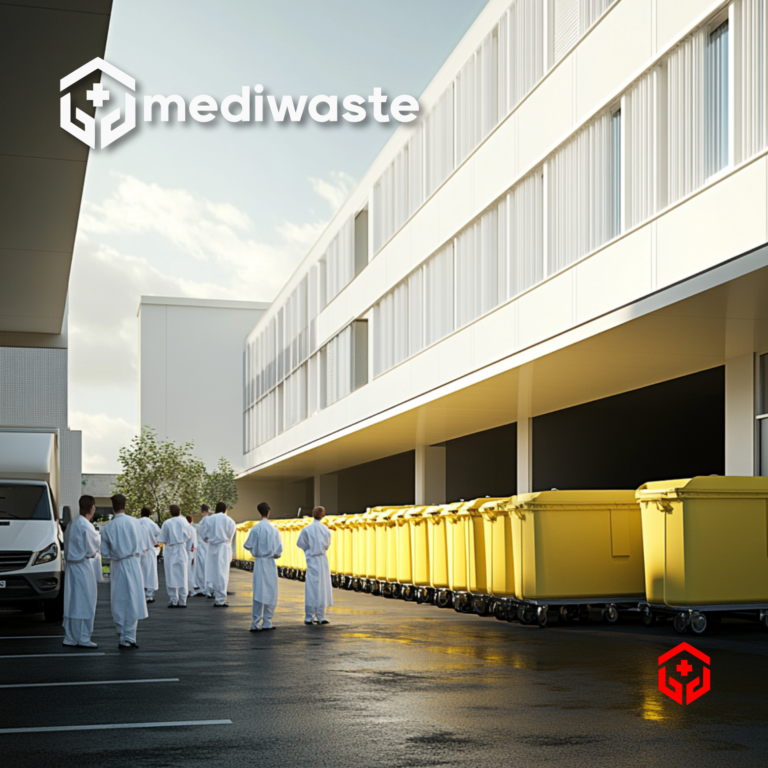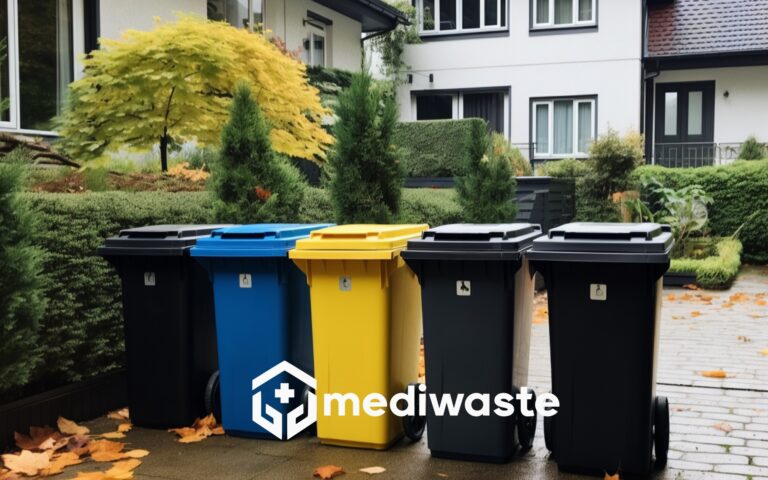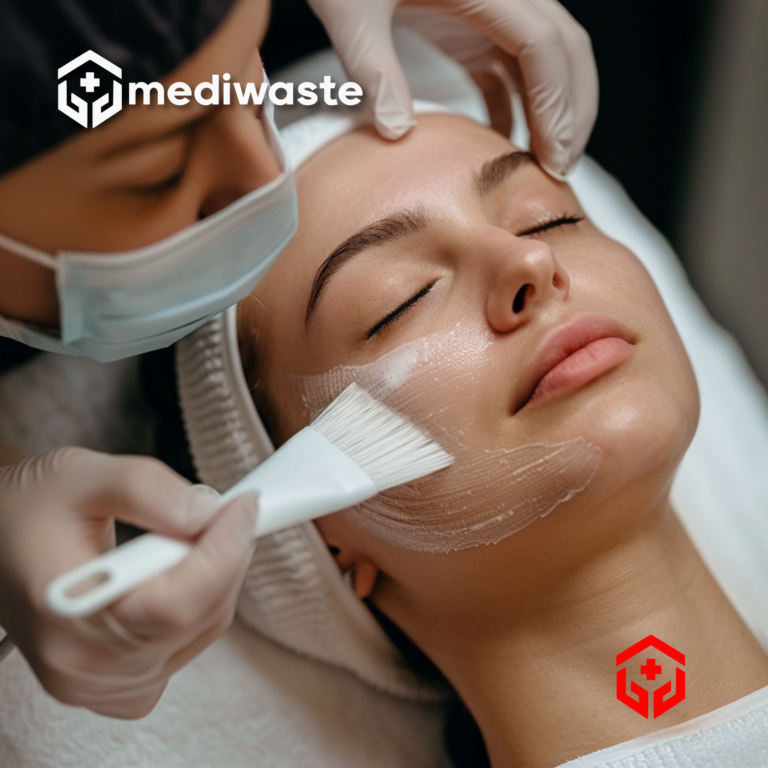Implementing a Color-Coded Waste Segregation System in Your Cosmetic Clinic
Proper waste segregation is crucial for cosmetic clinics to ensure safety, regulatory compliance, and environmental protection. Implementing a color-coded waste segregation system is an effective way to manage the various types of waste generated in these settings. This article outlines best practices for implementing such a system in your cosmetic clinic.

Understanding the Importance of Waste Segregation
Cosmetic clinics generate various types of waste, including:
- Clinical waste (contaminated materials)
- Sharps waste (needles, syringes, blades)
- Pharmaceutical waste
- Chemical waste
- General waste
MediWaste, the leading provider of medical waste management solutions, emphasizes that proper waste segregation is essential for:
- Ensuring regulatory compliance
- Minimizing environmental impact
- Reducing the risk of injuries and infections
- Optimizing waste disposal costs
The Color-Coded Waste Segregation System
The Department of Health’s HTM 07-01 Safe Management of Healthcare Waste Memorandum outlines a best practice color-coding scheme for waste segregation. Here’s how to implement this system in your cosmetic clinic:
1. Yellow: Clinical Highly Infectious Waste
- Purpose: For category A pathogens and medicinally contaminated waste
- Examples: Disposable PPE and garments contaminated with infectious bodily fluids, sharps contaminated by medicinal products and bodily fluids
- Disposal: Requires incineration
- EWC Codes: 18 01 03 and 18 01 09 (Human), 18 02 02 (Animal)
MediWaste provides yellow clinical waste bins and sharps containers specifically designed for this waste stream.
2. Orange: Clinical Infectious Waste
- Purpose: For hazardous and non-hazardous waste from patients with known or suspected infectious diseases
- Examples: Disposable PPE used when in contact with a known or suspected infectious patient
- Note: Medicines and anatomical waste must not be disposed of in this stream
- EWC Codes: 18 01 03 (Human)
MediWaste offers orange clinical waste bins, bags, and sharps containers for proper segregation of this waste type.
3. Purple: Cytotoxic and Cytostatic Waste
- Purpose: For disposal of cytotoxic and cytostatic medicines and contaminated items
- Examples: Syringes or vials used for botulinum toxin injections
- Disposal: Requires specialized handling and disposal
MediWaste provides purple-lidded sharps containers specifically for cytotoxic and cytostatic waste.
4. Blue: Medicinal Waste
- Purpose: For non-cytotoxic and non-cytostatic medicines
- Examples: Expired or unused medications, contaminated packaging
- Disposal: Requires specialized pharmaceutical waste disposal
MediWaste offers blue pharmaceutical waste bins for safe storage and disposal of medicinal waste.
5. Black and Yellow Striped: Offensive Waste
- Purpose: For non-hazardous, non-infectious waste that cannot be placed into the general waste stream
- Examples: Incontinence pads, non-infectious dressings
- Disposal: Can be recycled, incinerated, or deep landfilled
- EWC Codes: 18 01 04 and 20 01 99
MediWaste provides black and yellow striped bags for offensive waste segregation.
6. Black: General Waste
- Purpose: For non-hazardous, non-clinical waste
- Examples: Paper, uncontaminated packaging, food waste
- Disposal: Standard municipal waste disposal
Implementing the Color-Coded System
To effectively implement this system in your cosmetic clinic:
- Conduct a Waste Audit: Assess the types and quantities of waste generated in your clinic.
- Provide Appropriate Containers: Ensure each treatment area has the necessary color-coded bins and bags.
- Clear Labelling: Label all containers clearly with waste types and any specific instructions.
- Staff Training: Provide comprehensive training on the color-coding system and proper waste segregation.
- Use Visual Aids: Display color-coded posters in waste disposal areas as reminders for staff.
MediWaste offers downloadable color-coded posters to help reinforce proper waste segregation practices in your clinic.
Benefits of Proper Waste Segregation
Implementing a color-coded waste segregation system offers several benefits:
- Regulatory Compliance: Ensures adherence to government regulations and industry standards.
- Cost Efficiency: Reduces unnecessary incineration and overtreatment of waste.
- Environmental Protection: Minimizes the production of climate-changing emissions.
- Safety: Reduces the risk of needle-stick injuries and exposure to hazardous materials.
- Sustainability: Promotes recycling and proper disposal of different waste streams.
Conclusion
Implementing a color-coded waste segregation system is a crucial step in managing medical waste effectively in your cosmetic clinic. By following the Department of Health’s guidelines and partnering with experienced waste management providers, you can ensure regulatory compliance, enhance safety, and contribute to environmental protection.
MediWaste is committed to supporting cosmetic clinics in implementing effective waste segregation systems. Our comprehensive services, expertise in regulatory compliance, and innovative waste management solutions make us an ideal partner for clinics looking to improve their waste management practices and ensure ongoing compliance.
Contact MediWaste
For expert guidance on implementing a color-coded waste segregation system in your cosmetic clinic, contact MediWaste today. Our team of specialists can provide tailored solutions to help your facility optimize its waste management practices, ensure regulatory compliance, and minimize environmental impact.
Whether you’re looking to improve your current waste segregation system or implement a comprehensive new program, MediWaste has the expertise and resources to support your goals. Reach out to us to schedule a consultation and take the first step towards more efficient, compliant, and sustainable waste management in your cosmetic clinic.






